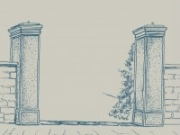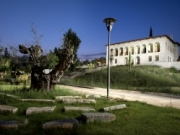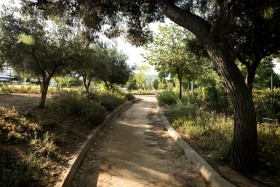Ilissos River
The area of the River Ilissos in ancient times
A major religious centre grew in the valley
formed on both sides of the river Ilissos banks, on the eastern side of the
Akropolis hill, with sanctuaries dedicated to Zeus, Apollo, Gaea, Kronos and
Rea, Artemis, Pan, Acheloos and the Nymphs. The temple of Olympian Zeus (6th-2nd
century BC) was prominent among them. As only part of its colonnades has been
preserved, it has become known as the “columns” of Olympian Zeus. Hadrian’s Gate
(131/2 AD) is also included among the monuments in the immediate vicinity.
The Early Christian Ilissos Basilica (5th-6th
century)
A large three-aisled Christian Basilica was
built on the small Ilissos isle called Vatrachonisi (“the Frogs Isle”) in the1st
half of the 5th century. Only few remains are nowadays preserved. A funerary
underground chamber (known as a martyrium) of a presumably older date (4th
century?) stands at the outer northern side of the Basilica, bearing traces of
murals and marble revetment. During excavations carried out in 1916-1917, parts
of the floor mosaics of the Basilica were removed and transferred to the
Byzantine Museum and are now on display in its permanent exhibition.
The Ilissos area, 20th-21st century
The landscape on the banks of the Ilissos
changed dramatically in mid-20th century, when the river was entombed, and
Vassileos Konstantinou and Kalirroes Avenues were constructed over the river
bed, following its route. Although the landscape was entirely altered because of
extensive building activity that had negative effects on the environment, the
present-day broader area around the Temple of Zeus (“Olympeion”) functions as
an archaeological park, offering an idea, albeit very fragmentary, of the
fluvial landscape of the past.
Ilissos River and VILLA ILISSIA
The building complex of “Villa Ilissia” was built near the banks of the Ilissos River as the winter residence for Sophie de Marbois-Lebrun (1785-1854), Duchess of Plaisance. The villa, completed by architect Stamatis Kleanthis in 1848, was ceded to the Greek army after the death of the Duchess. Since 1930 it has been used to house the Byzantine and Christian Museum.
A gateway, found in the Museum grounds in 2007, may have originally been the main entrance to the building complex on Vasilissis Sophias Ave. Similar pillars were used to decorate entrances of Athenian mansions in the early 20th century.
 | |
 | © BXM 2016 | photo: Aspasia Ioakeimidi |








